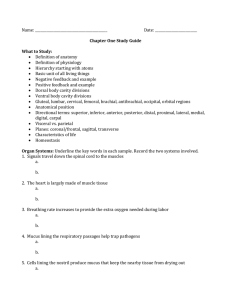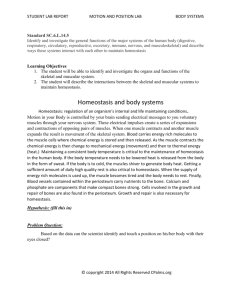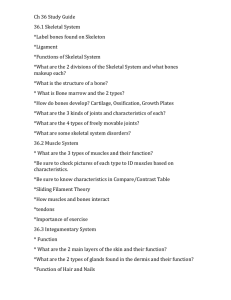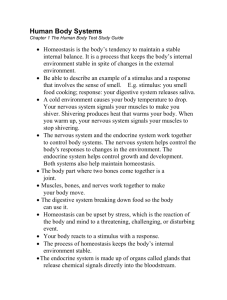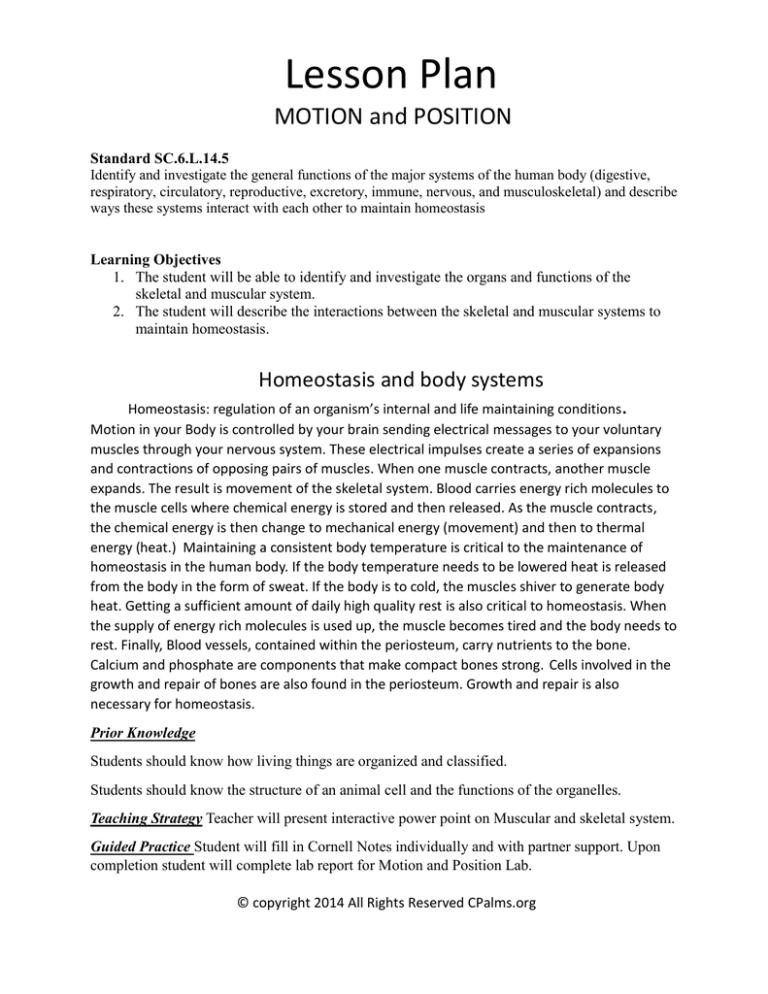
Lesson Plan
MOTION and POSITION
Standard SC.6.L.14.5
Identify and investigate the general functions of the major systems of the human body (digestive,
respiratory, circulatory, reproductive, excretory, immune, nervous, and musculoskeletal) and describe
ways these systems interact with each other to maintain homeostasis
Learning Objectives
1. The student will be able to identify and investigate the organs and functions of the
skeletal and muscular system.
2. The student will describe the interactions between the skeletal and muscular systems to
maintain homeostasis.
Homeostasis and body systems
Homeostasis: regulation of an organism’s internal and life maintaining conditions.
Motion in your Body is controlled by your brain sending electrical messages to your voluntary
muscles through your nervous system. These electrical impulses create a series of expansions
and contractions of opposing pairs of muscles. When one muscle contracts, another muscle
expands. The result is movement of the skeletal system. Blood carries energy rich molecules to
the muscle cells where chemical energy is stored and then released. As the muscle contracts,
the chemical energy is then change to mechanical energy (movement) and then to thermal
energy (heat.) Maintaining a consistent body temperature is critical to the maintenance of
homeostasis in the human body. If the body temperature needs to be lowered heat is released
from the body in the form of sweat. If the body is to cold, the muscles shiver to generate body
heat. Getting a sufficient amount of daily high quality rest is also critical to homeostasis. When
the supply of energy rich molecules is used up, the muscle becomes tired and the body needs to
rest. Finally, Blood vessels, contained within the periosteum, carry nutrients to the bone.
Calcium and phosphate are components that make compact bones strong. Cells involved in the
growth and repair of bones are also found in the periosteum. Growth and repair is also
necessary for homeostasis.
Prior Knowledge
Students should know how living things are organized and classified.
Students should know the structure of an animal cell and the functions of the organelles.
Teaching Strategy Teacher will present interactive power point on Muscular and skeletal system.
Guided Practice Student will fill in Cornell Notes individually and with partner support. Upon
completion student will complete lab report for Motion and Position Lab.
© copyright 2014 All Rights Reserved CPalms.org
Lesson Plan
MOTION and POSITION
Laboratory Exercise
Teacher will assign leveled cooperative groups of four students each. Groups should be based on
pre assessment data. Teacher will pass out lab task roles and students will wear them around
their necks. Teacher will pass out student lab reports.
Students should be given time to read and discuss in the groups the lab activity. After discussing
their understanding of the lab with their partners, teacher should ask probing questions in round
robin style to confirm student understanding of the task at hand.
Hypothesis
S/W generate a hypothesis in response to the problem question.
Problem Question:
Based on the data can the scientist identify and touch a position on his/her body with their eyes
closed?
Guiding Questions: What are the guiding questions for this lesson?
1. How do the skeletal and muscular systems work together to maintain homeostasis?
Blood cells are created in the bone marrow inside of the bones of the skeletal system.
Blood vessels contained within carry nutrients to the bone. Muscles attach to the bones.
Muscles engage in shivering in order to increase body temperature when needed.
2. What is the general function of the skeletal system? The skeletal system provides
structure and framing for our bodies. It protects our organs and gives the body shape.
3. What is the general function of the muscular system? The muscle provides a place for
the bones to attach and aide in movement of the body.
4. Why is homeostasis important to the human body? Homeostasis is a healthy state of
balance of all body systems. In order for the body to function and maintain itself and to
do work, homeostasis must be maintained.
© copyright 2014 All Rights Reserved CPalms.org
Lesson Plan
MOTION and POSITION
PROCEDURE
Student Directions:
One student in the group will close his eyes and raise both hands over his head. All other
group members will watch and make sure his eyes stay shut. The recorder in the group
will fill in the data table as the student successfully or unsuccessfully completes the task.
1. With both hands raised over his/her head, the left hand should be held completely still
without movement or waving.
2. Student should then use the index finger on his right hand to touch the tip of his/her
nose. From the tip of his nose, he should immediately raise his hand up again and
immediately touch his/her left thumb.
3. The index finger returns to touch the nose again and then immediately touches the
index finger on the left hand.
4. The index finger returns to touch the nose and then touches the middle finger on the
right hand.
5. The index finger returns to touch he nose and then touches the ring finger on the left
hand.
6. The index finger returns to touch the nose and then touches the pinky on the left hand.
7. The same student repeats the whole process again but switches hands from left to
right.
8. Each student should repeat the process following all the above steps.
9. Students should alternate responsibility of recording data.
© copyright 2014 All Rights Reserved CPalms.org
Lesson Plan
MOTION and POSITION
Directions: The recorder will put a check when the correct fingers make contact and an X if the
fingers touch in the wrong place or do not touch at all.
LEFT HAND
Latin names
Nose
Left thumb
Left index
Left Middle
finger
Left Ring
finger
Left Pinky
Nases
Pollex
Digitus
Segundus
Manus
Digitus
Me’dius
Digitus
Annula’ris
Digitus
Mi’nimus
Ma’nus
Student #1
Student #1
Student #3
Student #4
TOTALS
There actually are no muscles in our fingers. Fingers are moved by tendons, pulled by muscles in the
forearm. That's why if you flex your fingers, you can feel the muscles in your forearm. You could say that
we don't directly control our fingers at all. The muscles in the forearm and palm are connected to the
finger bones by smooth, flexible strings called tendons. The way our finger joints bend is by the muscles
pulling on these tendons.
RIGHT HAND
Latin names
Nose
Right
thumb
Right index
Right Middle
finger
Right Ring
finger
Right Pinky
Nases
Pollex
Digitus
Segundus
Manus
Digitus
Me’dius
Digitus
Annula’ris
Digitus
Mi’nimus
Ma’nus
Student #1
Student #1
Student #3
Student #4
TOTALS
Conclusions:
© copyright 2014 All Rights Reserved CPalms.org
Lesson Plan
MOTION and POSITION
1. Based on the totals in your data table, was each student more successful at one side or the
other? Why or why not? Defend your answer.
Generally speaking success in this task seems to be a functions of which hand with which
the student writes.
2. Summarize the following in your own words. Since it is known that we have no muscles
in our fingers explain how we are able to move our fingers?
There actually are no muscles in our fingers. Fingers are moved by tendons, pulled by
muscles in the forearm. That's why if you flex your fingers, you can feel the muscles in
your forearm. You could say that we don't directly control our fingers at all. The muscles
in the forearm and palm are connected to the finger bones by smooth, flexible strings
called tendons. The way our finger joints bend is by the muscles pulling on these
tendons.
3. Explain in numbered steps how our brain generates movement in our body?
1. Motion in your Body is controlled by your brain sending electrical messages to you
voluntary muscles through your nervous system.
2. These electrical impulses create a series of expansions and contractions of opposing
pairs of muscles.
3. When one muscle contracts and another muscle expands the result is movement of
the skeletal system.
4. See the chart below. These are the joints in the human body. Identify which kinds of
joints are found in your fingers and wrists and describe the motion of the joint.
Hinge joints are found in the fingers. This joint has a smaller range and has a back and
forth motion like a door. Gliding joints are found in the wrist. This joint is where one part
of the bone slides over another and they also move back and forth.
Pivot: One bone rotates in a ring of another bone that does not move. Turning your head is an example.
Ball and Socket: This a ball with a rounded end that fits in the cavity of another bone. Swinging arms and
legs in any direction is an example of this motion.
Hinge: This joint has a smaller range and has a back and forth motion like a door. These joints are found
in elbows, knees and fingers.
Gliding: This joint is where one part of the bone slides over another and they also move back and forth.
They are found in wrists ankles and in between vertebrae
© copyright 2014 All Rights Reserved CPalms.org
Lesson Plan
MOTION and POSITION
5. Beginning with a thought in your brain, explain the process of how you can voluntarily
move your body?
Motion in your Body is controlled by your brain sending electrical messages to you
voluntary muscles through your nervous system. These electrical impulses create a
series of expansions and contractions of opposing pairs of muscles. When one muscle
contracts and another muscle expands the result is movement of the skeletal system.
6. Temperature control is critical to the health of our bodies. Explain the relationship of the
muscular and skeletal system and how they contribute to controlling temperature for the
purpose of homeostasis.
As the muscle contracts the chemical energy is then change to mechanical energy
(movement) and then to thermal energy (heat.) Maintaining a consistent body
temperature is critical to the maintenance of homeostasis in the human body. If the
body temperature needs to be lowered heat is released from the body in the form of
sweat. If the body is to cold, the muscles shiver to generate body heat.
7. In summary how do calcium and phosphorous contribute to homeostasis.
Calcium and phosphate are components that make compact bones strong.
8. Describe the processes that occur in the periosteum and how they contribute to
homeostasis.
Blood vessels contained within the periosteum carry nutrients to the bone. Calcium and
phosphate are components that make compact bones strong. Cells involved in the
growth and repair of bones are also found in the periosteum. Growth and repair is also
necessary for homeostasis.
Pick only one of the following.
9. Do you think homeostasis is important to the maintenance of your health? Defend your
answer with 3 well written paragraphs.
10. Design a poster that describes homeostasis. Illustrate with colorful pictures 6 different
ways your body maintains a healthy balance at all times.
© copyright 2014 All Rights Reserved CPalms.org

